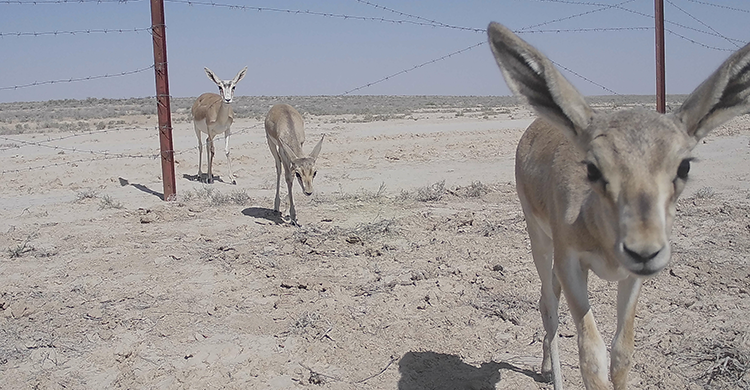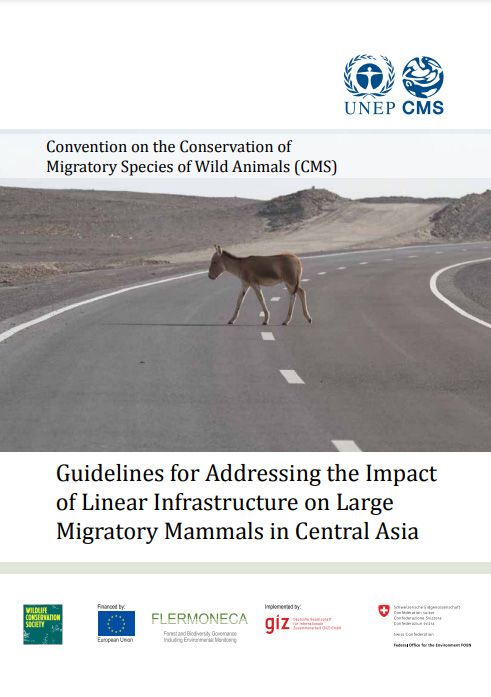Information on Previously Unknown Leopard Sightings in Turkmenistan May Contribute to the Species Conservation

Persian leopard © H. Tizruyan and K. Ateni
Authors: A.V. Gorbunov, Head of the Department of Biology, Ecology, Physiology and Pharmacology, Saratov State Agrarian University named after N.I. Vavilov (Russia); V.M. Korshunov, General Zoologist, Fujairah Environment Authority USE, previously worked at the Kopetdag State Reserve (Turkmenistan); E.A. Rustamov, Independent Expert, Small Grants Project Implementer, The Critical Ecosystem Partnership Fund (CEPF/WWF).
Bonn, 11 January 2023 – Turkmenistan is the home for the world’s second largest population of the Persian leopard (Panthera pardus) after Iran. The IUCN Red List classifies this subspecies of leopard as ‘Endangered’, and, according to various estimates, it inhabits from nine to thirteen countries as in some of them the species numbers have declined to single individuals.
In December 2020, the Ministry of Agriculture and Environmental Protection of Turkmenistan hosted an online meeting on the Persian leopard conservation. At the meeting, participants discussed different matters regarding the cooperation of national experts and the Centre for Large Landscape Conservation (CLLC, USA) under Memorandum of Understanding. In 2019-2021, the main leopard habitats in Kopetdag and Badkhyz were surveyed together with experts from the Norwegian Institute for Nature Research (NINA, Norway) and Tatjana Rosen, a zoologist from CLLC/USA. Some results on the distribution and abundance of this and other species using camera traps have already been published (Kaczensky at all., 2019; Rosen at all., 2022).
The current status of the Persian leopard (Panthera pardus ciscaucasica, Satunin, 1914) in Turkmenistan is reflected in this species study in the new edition of the Red Book of Turkmenistan (Rustamov, Khojamuradov, 2022). In Turkmenistan, the species is currently present only in the northern part of its historical range, whereas in the middle of the last century, it was distributed throughout all mountainous areas of the country. In the 1990s, the species numbers have noticeably declined, and over the last 10-15 years its range has become more fragmented. At present, the Turkmen population is highly fragmented and covers only some ridges and gorges of limited areas in the Great Balkan, Western and Central Kopetdag, and Western Badkhyz mountains.
The study’s section on the species protection measures mentions the need for a national action plan for the conservation and management of the leopard population and the importance of transboundary cooperation.

Points of previously unknown sightings of the leopard in Turkmenistan (explained in the text).
The borders of the species’ modern range in Turkmenistan passes through the Great Balkan Range, the northern slopes of the Kopetdag Mountains, and the Western Badkhyz. Earlier observations in the 1990s showed that single leopard individuals, usually adult males, entered adjoining territories, particularly the Western Uzboy and the Northwestern Turkmenistan, including the tracts of Ersary-Baba and Depme (Gorbunov, Lukarevsky, 1991; Lukarevsky, 1995; Ishadov et al., 1999). The crossings can be of considerable length in time and distance at times, reaching up to 500-600 km, e.g., northwards from the Northwestern Kopetdag through the Great Balkan Range to the Western Ustyurt in Kazakhstan (Pestov, 2019; Pestov et al., 2019a, 2019b). Often the leopard individuals do not return in such cases; however, if the habitat conditions in an area where the predator has entered are ecologically unfavorable and an area itself is relatively close to the main range, a return of the animal seems to be possible.
Previously unknown and unpublished historical observations, which recently were made available, might be useful for the research planning and, hence, shed some light on the leopard movements within the Turkmen borders. In May 1957, I. Efimov and V.A. Zarkhidze, former employees of the Krasnovodsk Department of the Turkmen Anti-Plague Station (now the Centre for Prevention of Especially Dangerous Infections of the State Sanitary and Epidemiological Service of the Ministry of Health and Medical Industry of Turkmenistan)1, recorded fresh leopard tracks in the valley of the Western Uzboy, in a turang grove near the Jamal-Togolok well (point 1, coordinates 39.908901, 56.062572). In addition to the tracks, zoologists noted leopard scrape marks on a fallen turang tree (Pópulus pruinósa). In April 1981, to the northeast of the same area, a zoologist clearly observed an adult leopard coming from the southwest of Koymatdag cliff (Point 2) at a distance of 600-700 m for 25-30 minutes. According to the author, the leopard came from the Uzboy valley - 100-110 km to the eastern part of the Great Balkan Range (Point 3). After this observation, intensified searches for leopard's presence signs in Koymatdag had yielded no results.
Later in 1987, clear pawprints and scrapes of an adult male were found on the soil in the Tedjen River valley, 50 km to the north of the range (Point 4). The timing details of its presence in this area are unknown. However, as its presence was not observed by hunters or local communities, it may indicate a brief stay of the animal in the area. The animal may have come from the south along the Tedjen River valley from the Western Badkhyz (150-160 km in a straight line from where the tracks were found) or from the Eastern Kopetdag (50-60 km), points 5 (35.76701073, 61.47199558) and 6 (36.627290, 60.641889) respectively.
The authors are convinced that the leopard came from the Eastern Kopetdag, which is also confirmed by the reports from border guards at the Turkmen-Iranian border. At Point 6, directly to the southwest from the checkpoint, traces of leopard activity were repeatedly noted during the regular censuses of ungulates and other large mammals in 1985-1987. According to observer’s opinion, the leopard migrated along the Chekhelkaman (Chelkeman) and then northeastwards towards the Tedjen River valley. In September 1987, no tracks of other predatory animals (caracal, red fox, jackal, wolf), which are usually found in the same riparian forests, were detected; probably, it was due to the presence of the leopard there. The aforementioned cases together with the previously known facts of the species encounters will allow to detail the general picture of spatio-temporal aspects of the migration, especially in the Kara-Bogaz (the northwest of Turkmenistan) and Ustyurt (the southwest of Kazakhstan) regions. This information is important for the protection of migrating leopard individuals, especially outside protected areas.
References
Gorbunov A.V., Lukarevsky V.S. 1991. Leopard sightings in Western Turkmenistan [in Russian]. Bulletin. MOIP, Dept. of Biology, Vol.96, Vol.1: 34-37.
Ishadov N., Imamberdyev V., Sadykov A. 1999. Leopard and cheetah in North-Western Turkmenistan. Problems of Conservation and Sustainable Use of Biodiversity of Fauna of Kazakhstan [in Russian]. - Almaty: 25-26.
Lukarevskii V.S. 1995. Leopard - Panthera pardus Linnaeus, 1758. Mammals of Turkmenistan [in Russian]. Vol.1: Predators, pinnipeds, ungulates. Ashkhabad, Ylym: 148159.
Pestov M.V., Nurmukhambetov J.E., Mukhashov A.T., Terentyev V.A. 2019. The Persian leopard (Panthera pardus saxicolor (Pocock, 1927) and Asian jackal (Canis aureus Linnaeus, 1758) are new species for the territory of Ustyurt State Nature Reserve (Kazakhstan) [in Russian]. Selevinia 2018. Vol.26, Almaty: pp.58-64.
Rustamov E.A., Khojamuradov H.I. 2022. Panthera pardus Linnaeus, 1758. Leopard (leopard). Red Data Book of Turkmenistan. Invertebrate and vertebrate animals. Edited edition 4. (in press) [in Russian].
Kaczensky P., Rustamov E., Karryeva Sh., Iankov P., Hudaykuliev N., Saparmyradov J., Veyisov A., Shestopal A., Mengliev Sh., Hojamyradov H., Potaeva A., Kurbanov A., Amanov A., Khekimov G., Tagiyev C., Rosen T., Linnell J.D.C. 2019. Rapid assessments of wildlife in Turkmenistan 2018. NINA report 1696, Trondheim, Norway. https://brage.nina.no/nina-xmlui/handle/11250/2639265.
Rosen T., Amanov A., Barashkova A., Dieterich T., Hojamuradov H., Hudaikuliev N., Karryeva Sh., Kaczensky P., Mengliev Sh., Muhashov A., Nurmuhambetov Zh., Pestov M., Potaeva A., Smelansky I., Terentyev V., Veyisov A., Linnell J.D. 2022. FAO. Proceedings from the International Cold Winter Desert Conference - Central Asian Desert Initiative. 2-3 December, Tashkent, Uzbekistan. Tashkent. 79-86. https://doi.org/10.4060/cc1339en.
Pestov M.V., Laktionov A.P., Dieterikh T.P., Sultanova B.M., Nurmukhambetov J.E., Mukhashov A.T., Terentyev V.A., Denisov D.A. 2019a. Results of comprehensive expeditions to southern Ustyurt in 2017-2019. Biodiversity Assessment, CADI project "Central Asian Deserts Initiative". Nur-Sultan. ACBK. 164 p. https://www.researchgate.net/publication/344997766.
Pestov M.V., Nurmukhambetov Z.E., Munkhashov A.T., Terentyev V.A., Rosen T.A. 2019b. First camera trap record of Persian leopard in Ustyurt State Nature Reserve, Kazakhstan. Cat News, 69, Spring: 14-16.
Last updated on 05 May 2023




